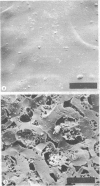Abstract
The clinical use of uncoated charcoal haemoperfusion systems, despite their efficacy, has hitherto been prevented by the occurrence of a number of adverse effects including charcoal embolism and marked thrombocytopenia. Charcoal coated with a synthetic hydrogel overcomes many of the disadvantages associated with the use of uncoated material in that there is a much reduced thrombocytopenia and no evidence of charcoal embolism. Six patients, severely poisoned as a result of overdoses of either a barbiturate or glutethimide, were haemoperfused using such a system. Four made complete recoveries, and the two patients who died had both suffered cardiorespiratory arrests before perfusion. In contrast to haemodialysis charcoal haemoperfusion is simple to initiate, less expensive in terms of manpower and equipment, and gives superior clearance data for all barbiturates and glutethimide. We believe that this technique may have a significant role to play in the management of the severely poisoned patient.
Full text
PDF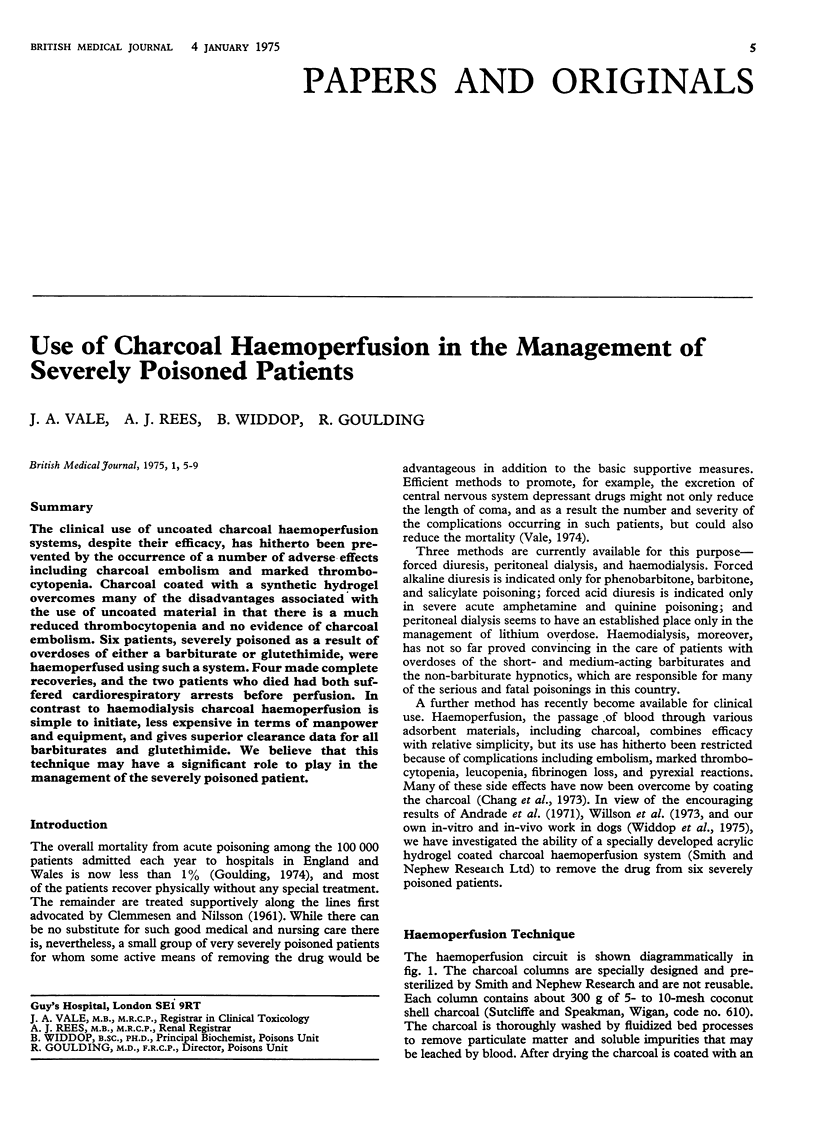
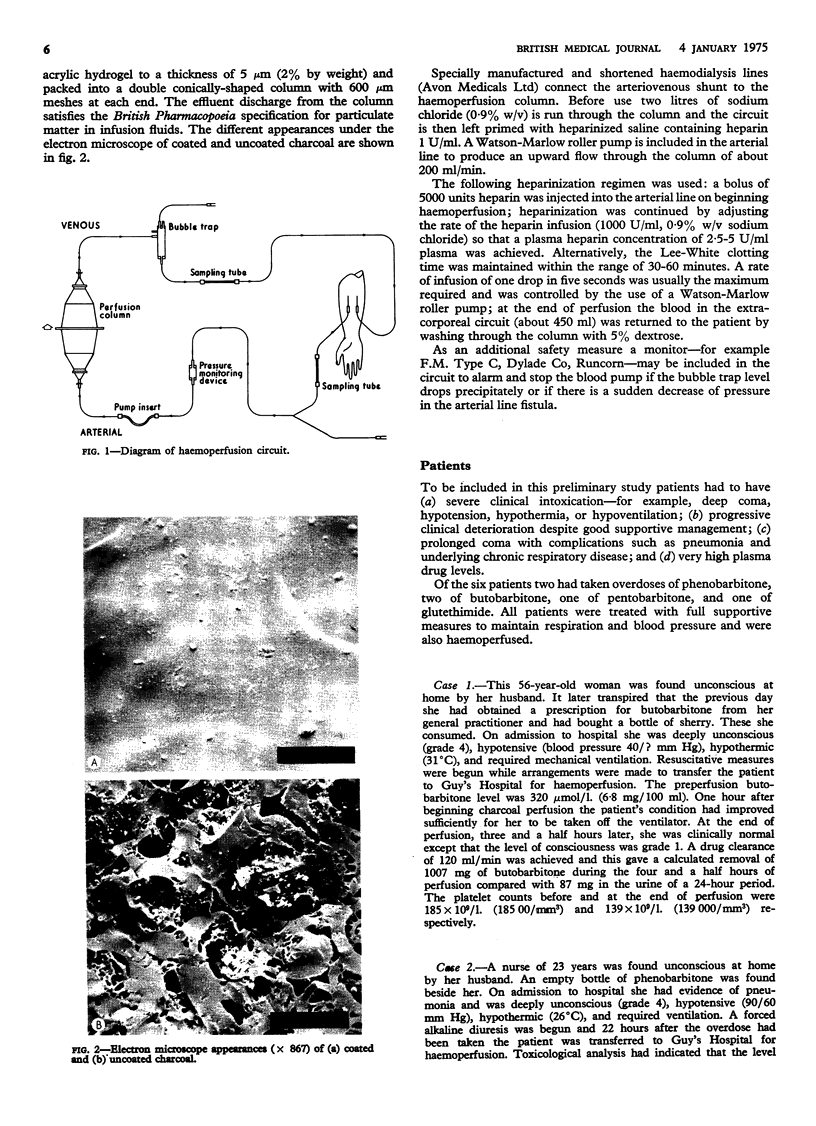
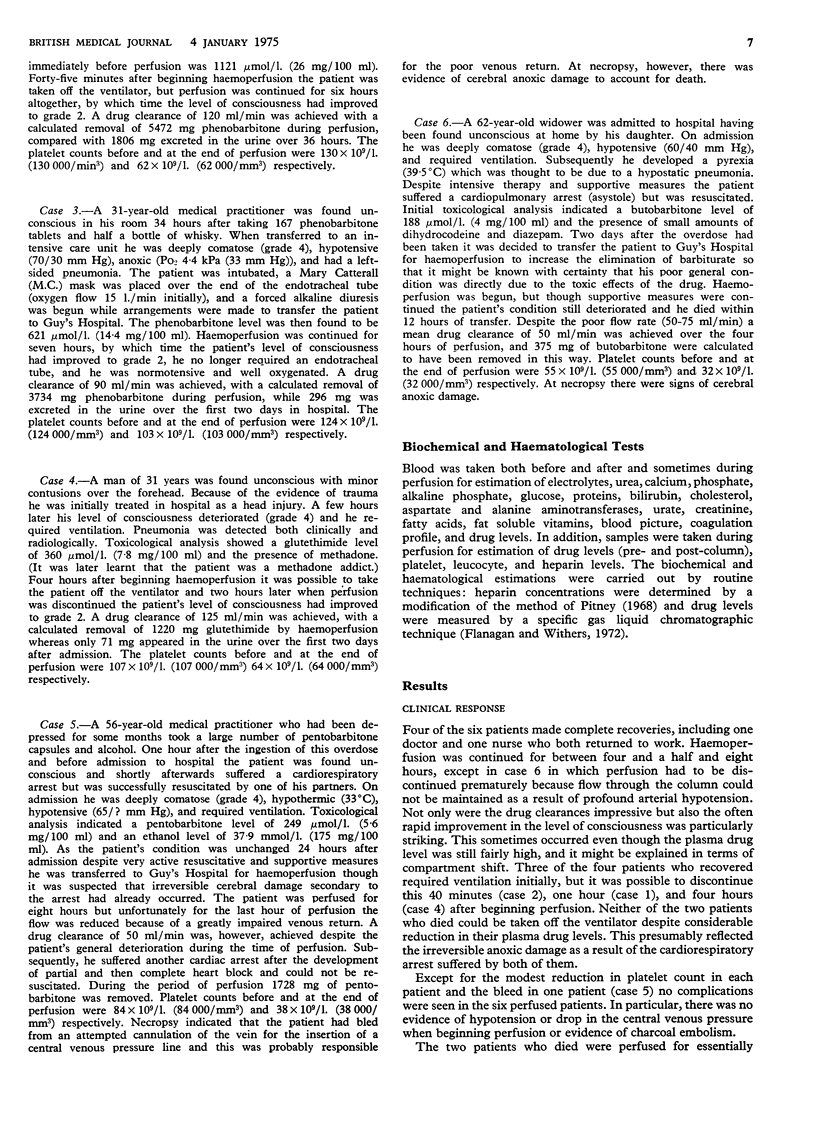
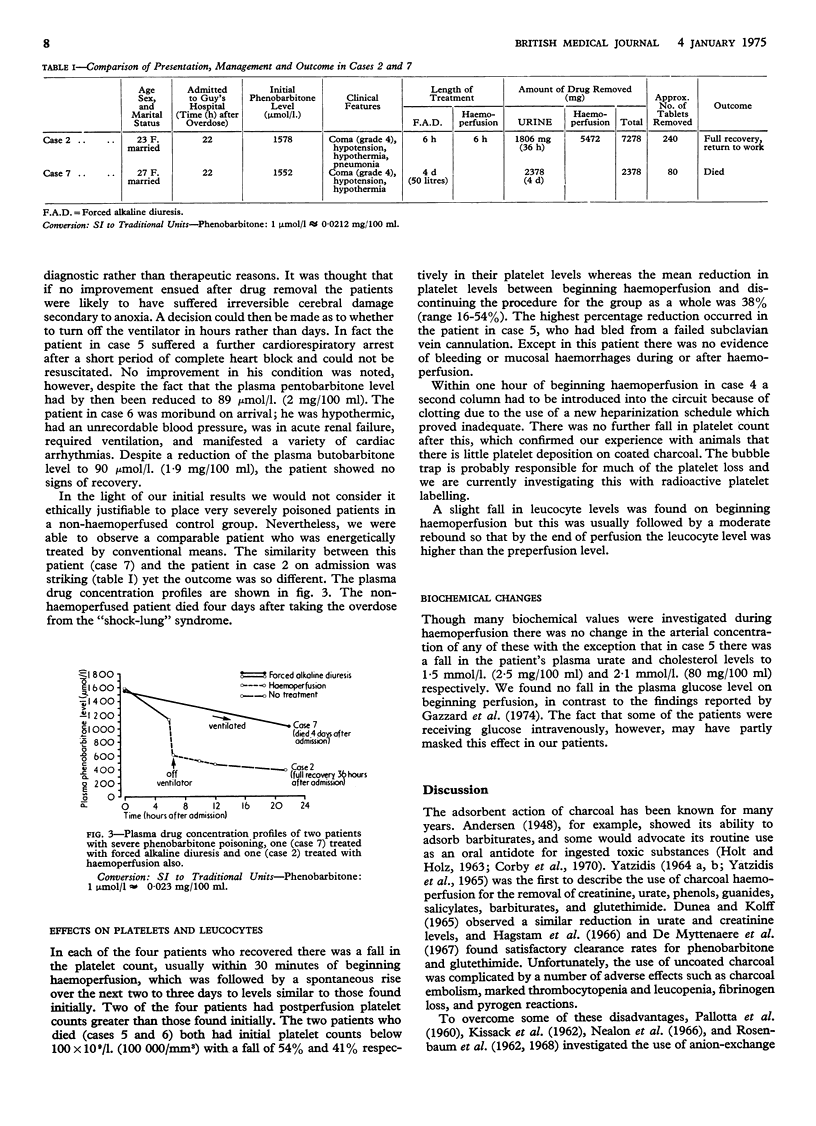
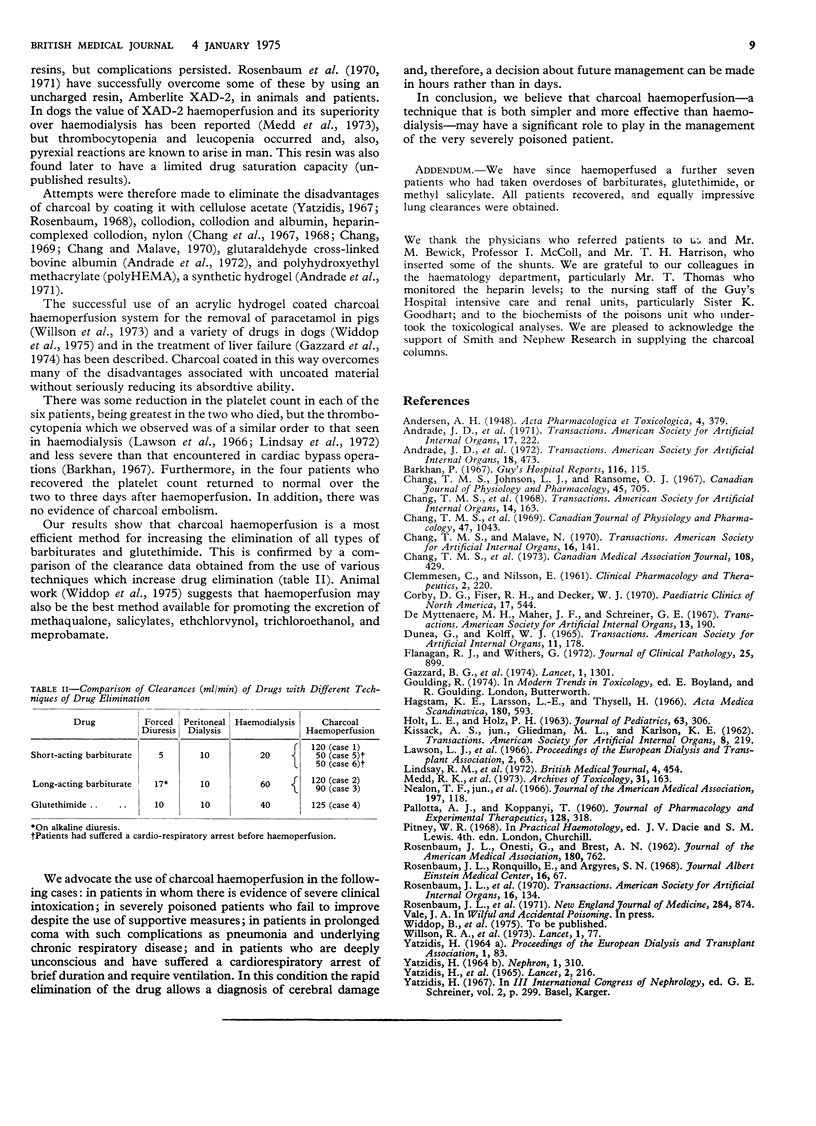
Images in this article
Selected References
These references are in PubMed. This may not be the complete list of references from this article.
- CLEMMESEN C., NILSSON E. Therapeutic trends in the treatment of barbiturate poisoning. The Scandinavian method. Clin Pharmacol Ther. 1961 Mar-Apr;2:220–229. doi: 10.1002/cpt196122220. [DOI] [PubMed] [Google Scholar]
- Chang T. M., Johnson L. J., Ransome O. J. Semipermeable aqueous microcapsules. IV. Nonthrombogenic microcapsules with heparin-complexed membranes. Can J Physiol Pharmacol. 1967 Jul;45(4):705–715. doi: 10.1139/y67-083. [DOI] [PubMed] [Google Scholar]
- Chang T. M., Malave N. The development and first clinical use of semipermeable microcapsules (artificial cells) as a compact artificial kidney. Trans Am Soc Artif Intern Organs. 1970;16:141–148. [PubMed] [Google Scholar]
- Chang T. M. Removal of endogenous and exogenous toxins by a microencapsulated absorbent. Can J Physiol Pharmacol. 1969 Dec;47(12):1043–1045. doi: 10.1139/y69-170. [DOI] [PubMed] [Google Scholar]
- DUNEA G., KOLFF W. J. CLINICAL EXPERIENCE WITH THE YATZIDIS CHARCOAL ARTIFICIAL KIDNEY. Trans Am Soc Artif Intern Organs. 1965;11:178–182. doi: 10.1097/00002480-196504000-00035. [DOI] [PubMed] [Google Scholar]
- Flanagan R. J., Withers G. A rapid micro-method for the screening and measurement of barbiturates and related compounds in plasma by gas-liquid chromatography. J Clin Pathol. 1972 Oct;25(10):899–904. doi: 10.1136/jcp.25.10.899. [DOI] [PMC free article] [PubMed] [Google Scholar]
- Gazzard B. G., Weston M. J., Murray-Lyon I. M., Flax H., Record C. O., Williams R., Portmann B., Langley P. G., Dunlop E. H., Mellon P. J. Charcoal haemoperfusion in the treatment of fulminant hepatic failure. Lancet. 1974 Jun 29;1(7870):1301–1307. doi: 10.1016/s0140-6736(74)90678-3. [DOI] [PubMed] [Google Scholar]
- HOLT L. E., Jr, HOLZ P. H. THE BLACK BOTTLE. A CONSIDERATION OF THE ROLE OF CHARCOAL IN THE TREATMENT OF POISONING IN CHILDREN. J Pediatr. 1963 Aug;63:306–314. doi: 10.1016/s0022-3476(63)80344-3. [DOI] [PubMed] [Google Scholar]
- Hagstam K. E., Larsson L. E., Thysell H. Experimental studies on charcoal haemoperfusion in phenobarbital intoxication and uraemia, including histopathologic findings. Acta Med Scand. 1966 Nov;180(5):593–603. doi: 10.1111/j.0954-6820.1966.tb02875.x. [DOI] [PubMed] [Google Scholar]
- KISSACK A. S., Jr, GLIEDMAN M. L., KARLSON K. E. Studies with ion exchange resins. Trans Am Soc Artif Intern Organs. 1962;8:219–225. doi: 10.1097/00002480-196204000-00047. [DOI] [PubMed] [Google Scholar]
- Lindsay R. M., Kennedy A. C. Editorial 1972: Dialysers and blood loss in regular dialysis therapy. Proc Eur Dial Transplant Assoc. 1972;9:437–454. [PubMed] [Google Scholar]
- Medd R. K., Widdop B., Braithwaite R. A., Rees A. J., Goulding R. Comparison of haemoperfusion and haemodialysis in the therapy of barbiturate intoxication in dogs. Arch Toxikol. 1973;31(2):163–174. doi: 10.1007/BF00310394. [DOI] [PubMed] [Google Scholar]
- Medd R. K., Widdop B., Braithwaite R. A., Rees A. J., Goulding R. Comparison of haemoperfusion and haemodialysis in the therapy of barbiturate intoxication in dogs. Arch Toxikol. 1973;31(2):163–174. doi: 10.1007/BF00310394. [DOI] [PubMed] [Google Scholar]
- PALLOTTA A. J., KOPPANYI T. The use of ion exchange resins in the treatment of phenobarbital intoxication in dogs. J Pharmacol Exp Ther. 1960 Mar;128:318–327. [PubMed] [Google Scholar]
- Rosenbaum J. L., Kramer M. S., Raja R., Boreyko C. Resin hemoperfusion: a new treatment for acute drug intoxication. N Engl J Med. 1971 Apr 15;284(15):874–877. doi: 10.1056/NEJM197104222841603. [DOI] [PubMed] [Google Scholar]
- Willson R. A., Thompson R. P., Winch J., Williams R. Rapid removal of paracetamol by haemoperfusion through coated charcoal. In vivo and in-vitro studies in the pig. Lancet. 1973 Jan 13;1(7794):77–79. doi: 10.1016/s0140-6736(73)90470-4. [DOI] [PubMed] [Google Scholar]
- YATZIDIS H., OREOPOULOS D., TRIANTAPHYLLIDIS D., VOUDICLARI S., TSAPARAS N., GAVRAS C., STAVROULAKI A. TREATMENT OF SEVERE BARBITURATE POISONING. Lancet. 1965 Jul 31;2(7405):216–217. doi: 10.1016/s0140-6736(65)90698-7. [DOI] [PubMed] [Google Scholar]
- YATZIDIS H. RECHERCHES SUR L''EPURATION EXTRA R'ENALE 'A L'AIDE DU CHARBON ACTIF. Nephron. 1964;1:310–312. doi: 10.1159/000179343. [DOI] [PubMed] [Google Scholar]



